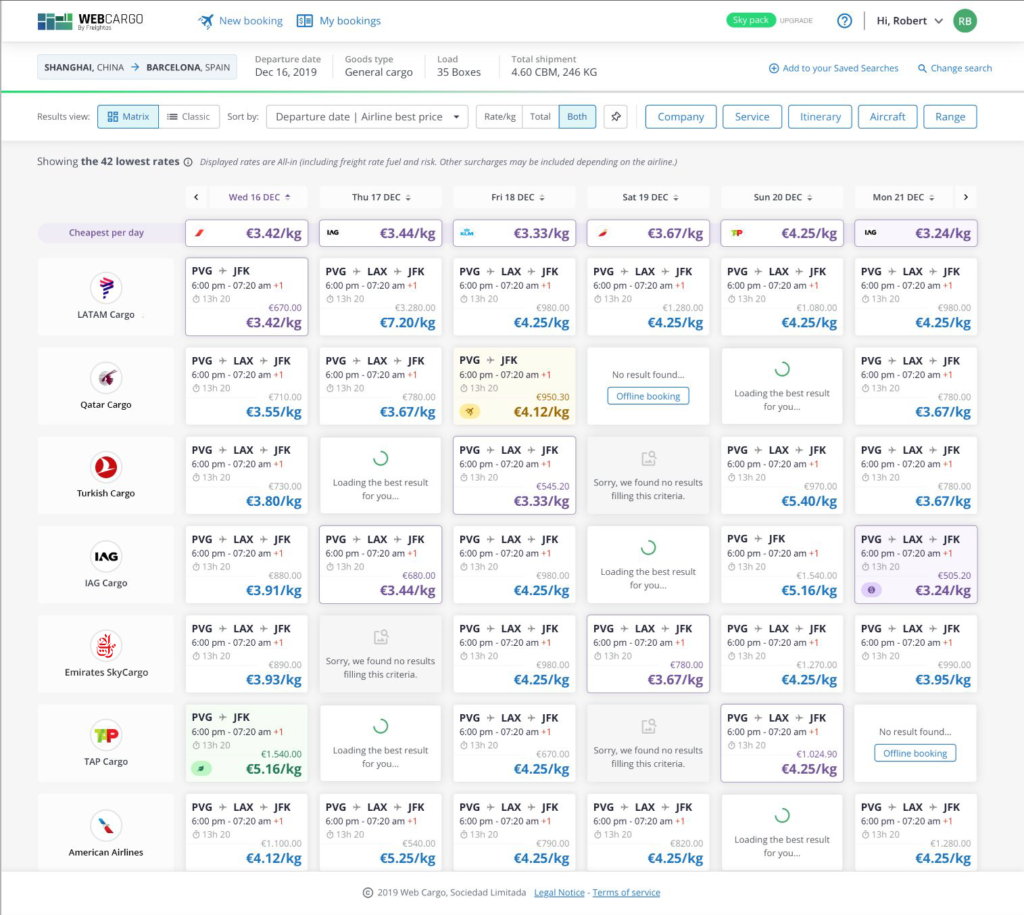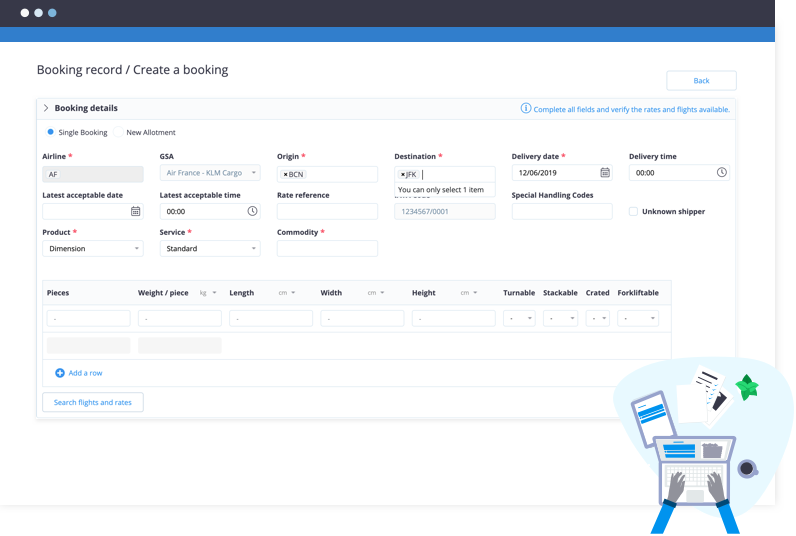Choosing a Freight Rate Management System [RMS]

Updated: February, 2024
Digital transformation is taking the world by the storm, especially for the freight and logistics industry. While technology seeks to centralize this widely fragmented industry, one of the key challenges still faced by freight forwarders is rate management inefficiency.
About 43% of a freight sales executive’s time is spent on pricing and quotes. Unregulated pricing, delayed quotes, and manual entries often cause errors in the process – which means losing time, money, and resources. This is eased by a Rate Management System.
Here’s everything you need to know about air and ocean freight rate management software.
You can also cut straight to the bottom line to learn more about WebCargo’s rate management systems.
Let’s dive in…
- What Is a Rate Management System?
- What Freight Rate Management Software Provides
- Manual vs. Digital Rate Management
- WebCargo’s Freight Rate Management Software
- Frequently Asked Questions about Rate Management Systems
What Is a Rate Management System?
As the name goes, freight rate management system is a software that enables logistics service providers (LSPs) and forwarders to manage freight quotes digitally – delivering better control and agility over the entire pricing process.
- Rate management software integrates various processes related to freight rate digitally like inquiries, booking, data management, etc. – reducing complexities and chances of manual error.
- It also gives flexible data points, like customized quotes, currency conversion, and pricing tracking, which are automated for maximum efficiency, fast query-resolution, and a seamless customer experience.
- Freight forwarders can store their purchasing rates and other freight quotes in a centralized, online system. This provides carriers, airlines, or shippers quick and easy access to a company’s freight rates anytime, anywhere.
[optin-monster slug=”rqdjmypa4grunipjndhf” followrules=”true”]
What Freight Rate Management Software Provides
1. Instant freight quotes
Given the uncertainty in the logistics industry, prices are volatile and customer demands keep changing. The greatest hassle for your pricing team is coordinating between carriers, shippers, and suppliers to curate freight quotes.
Good rate management software helps you to instantly accommodate any changes from customers and update quotes. It keeps the database in sync with the latest freight quotes and offers a personalized booking experience to customers with customizations.
2. Faster turnaround time
Is your pricing operations team still tangled up in the mess of rate sheets, PDFs, docs, and Excel sheets? The average turnaround time for spot quote requests across the industry is 67 hours. That’s close to 3 days wait for a customer. Imagine the opportunity costs!
With a freight rate management system, you can pull quotes much faster – in minutes, instead of days.
How? By instantly crawling contract rates from available carriers, and then using those rates to generate on-demand quotes according to customer queries. Forwarders who invest the time in developing internal processes become more effective and efficient, which helps business grow by providing high customer satisfaction.
3. A more efficient booking process
Forwarders simultaneously interact with numerous different parties in the logistics chain – such as customers, shippers, managers, transporters, etc. When the processes aren’t organized well, operational efficiency often takes the hit.
The ultimate goal of freight rate management software goes beyond just optimizing quotes and speeding up booking.
With end-to-end digitalization, rate management system helps achieve optimization and efficiency in your overall operations and processes. It provides real-time information to customers by integrating everything into one platform. In fact, the time and effort saved by an RMS increases team efficiency by up to 86%.
4. Transparency for customers
Customers don’t like to be blindsided by undisclosed charges and quotation delays. Lack of transparency among various stakeholders leads to unnecessary lags and costs incurred on account of miscommunication or untimely relay of information.
RMS fetches reliable data from carriers, transporters, and agents to provide your customer with detailed quotes online. It helps you provide a precise and transparent breakdown of all the costs involved in the shipping process to your customers in advance. Your team can also plan routes and optimize costs by relying on actionable data insights from an RMS.
5. A single-access data entry point, reducing the chance of error
Manual rate management systems are prone to human errors. In a typical pricing operation, the complex data is processed in spreadsheets like MS Excel. It is then assembled in rate sheets and folders which are sent to customers by email.
There are multiple problems with this process. To start with, it is long. The data entered can be changed at multiple locations, and it’s almost impossible to avoid errors. Even a minor deviation in data entry results in huge losses for you and your customers.
Did you know that 15% of all carrier invoices are incorrect and as much as 80% of logistics companies pay extra for freight services? Moreover, the industry incurs losses of about $700 million every year due to invoicing errors alone.
By incorporating a digital freight rate management system, you reduce the chances of error by limiting manual tasks performed by your team. With one entry-point for data entry, an RMS offers a single point-of-truth framework to extract accurate information from a central storage facility, meaning fewer errors due to misinformation and miscommunication.
[optin-monster slug=”uei8hmhuzsq3wazq783b” followrules=”true”]
6. Flexibility and agility
Forwarders have to work with different carriers and transporters to get shipments delivered. It is extremely important to have a dynamic database of all the prices in one place to offer quick spot quotes to customers.
Most rate management systems do not offer real-time rates or connections to partner forwarders. WebCargo’s solution does.
WebCargo’s rate management software helps you identify real-time freight rates from carriers and partner freight forwarders. Having these multiple options increases the sales rate, enabling you to optimize freight costs based on the best spot shipping rate available. In the logistics sector, supply and demand patterns vary based on numerous factors like traffic, season, eCommerce trends, and global events, among others. One day, you may have fewer orders and a limited network. The next day, you may see a massive surge in demand and would need to scale up your business operations quickly. Manual rate management makes it very hard to handle such variations in supply and demand patterns, especially when demands come in rapidly.
7. The right data reporting and analysis
The benefits of an RMS aren’t just limited to furnishing quotes and managing bookings. A rate management system also generates and gathers huge chunks of data every day, delivering exceptional insights for your business.
You can track key metrics such as:
- Number and percentage of quotes generated
- Quote turnaround time
- Contract upload and update speed
- Lead conversion rate & user adoption rate
- Win / Loss rate
Freight rate management software provides reliable and actionable information from customers as well as carriers. Readily-available data and visual dashboards make it easier to communicate KPIs to internal and external stakeholders. You can also analyze data and predict trends to make informed and data-backed decisions for your business operations.
Check out these 50+ expert-compiled tips on selecting and implementing a rate management platform.
Manual vs. Digital Rate Management
| # | Manual Operations | Digital RMS |
| 1 | Difficult to quickly adjust to changes in customer requirements | Flexibility to accommodate varying customer demands |
| 2 | Delays in spot quotes and response to customer requests | Quick turnaround time for freight quotes with fast incorporation of extra requests |
| 3 | Increased chance of human errors | Limiting errors by automating critical operations |
| 4 | Less transparency due to unstructured systems and miscommunication | More transparency in prices and supply chain for customers and vendors |
| 5 | Drop in team efficiency due to repetitive and disorganized operations | Increased efficiency with single-point planning, managing, and tracking of operations |
| 6 | Limited access to insightful data, increasing the chance of uninformed decision making | Data gathered, stored, and analyzed to provide actionable insights for decision-making |
| 7 | User experience is hampered | Better UX leads to easy adoption and longer retention |
WebCargo’s Freight Rate Management Software
WebCargo offers rates from over 370 carriers and manages end-to-end pricing operations for your business. And it also uniquely offers real-time spot pricing and booking options. No other platform supports static rate management alongside real-time connectivity. And it is increasingly critical for forwarders to manage both sides of the business.
Trusted by 10,000+ forwarders globally, the platform is fully digitized and manages all processes involved in freight quote booking. From automated rate ingestion to multimodal freight management, you can count on WebCargo for all pricing and booking operations.
Here are the benefits WebCargo provides:
1. Automated Rate and Quote Capabilities
WebCargo enables you to effectively utilize the pricing data with:
- Instant automated door-to-door routing and quoting
- Connection to eBooking platforms for quick conversion
- Easy access to rates and smooth organizational sharing of data
- Support for manual quoting
- Filters to accommodate exceptions
- Live market rate benchmarks
- Permission management across the company hierarchy
2. Smart Business Intelligence
WebCargo allows you to make informed decisions based on:
- Quotes and sales activity across company levels, customers, lanes, etc.
- Insights into changing consumer habits and win/loss performance
- Analysis of buy/sell rate trends in the market
3. Enhanced User Experience
Provide a seamless experience to your team as well as customers with:
- Intuitive technology that allows faster rollouts
- Training and onboarding support to make the transition smooth
- Robust API connectivity across several business tools
- Airtight security of your pricing data
- Regular updates to the software
Looking for a cutting-edge air freight rate management system? Get a demo of the industry’s leading RMS.
FAQ about Freight Rate Management
Q: What is a freight rate management system (RMS)?
A: A Rate Management System is software – typically cloud-based – that enables logistics service providers and freight forwarders to digitally manage freight rates and quoting quotes. The systems integrates various processes related to freight rate management, such as inquiries, booking, data management, and more, reducing manual errors and improving efficiency. These can vary by mode, like WebCargo’s air rate management platform.
Q: What are the main benefits of using Freight Rate Management Software?
A: The key benefits include instant freight quotes, faster turnaround times, a more efficient booking process, transparency for customers, a single-access data entry point to reduce errors, flexibility, agility in rate management, and insightful data reporting and analysis.
Q: How does digital rate management compare to manual operations?
A: Digital freight rate management offers flexibility to accommodate changing customer demands from shippers/BCOs looked for on-demand service, quick turnaround for freight quotes, reduced errors through automation, increased transparency, improved team efficiency, and access to actionable data for informed decision-making, unlike manual operations which are slower, error-prone, and less transparent.
Q: What does WebCargo’s Freight Rate Management Software offer?
A: WebCargo provides rates from over 370 carriers and supports real-time spot pricing and booking options, automated rate ingestion, multimodal freight management, instant automated routing and quoting, smart business intelligence for informed decisions, and an enhanced user experience with intuitive technology and robust API connectivity. It also includes real-time integrations with dozens of airlines via WebCargo’s leading air cargo booking platform.
Q: How does an RMS improve operational efficiency?
A: For freight forwarders, an RMS improves operational efficiency by centralizing freight rate data – whether contract or spot – automating the quoting process, providing real-time updates, and reducing manual tasks, which collectively save time, reduce errors, and enable better decision-making. When integrated with instant pricing and booking with carriers, as well as track and trace capabilities or integrations with transportation management systems (TMSs), it becomes a force multiplier.
Q: What is the impact of rate management inefficiency in the freight and logistics industry?
A: Inefficiency in rate management leads to unregulated pricing when creating pricing quotes or optimizing routing, delayed quotes, manual entry errors, loss of time, money, and resources. Based on WebCargo data, approximately 43% of a freight sales executive’s time is spent on pricing and quotes, highlighting the need for efficient rate management systems.
Q: Can rate management software handle fluctuations in the logistics industry?
A: Yes, rate management software is designed to be flexible and agile. As freight rates fluctuate, it’s more important to be capable of adjusting to real-time changes in the logistics industry, including volatile prices and varying customer demands, thus enabling businesses to respond quickly to market dynamics.
Q: How significant are data analytics in rate management?
A: Data analytics play a crucial role in rate management by providing valuable insights into operations, customer behavior, market trends, and performance metrics, which help in strategic planning, improving service offerings, and making informed business decisions. Analytics based on market data or internal capabilities must be aggregated in order to adapt businesses rapidly.
Q: What makes WebCargo’s rate management solution unique in the market?
A: WebCargo’s solution is unique because it offers both static rate management and real-time connectivity for spot pricing and booking, supported by a comprehensive digital platform trusted by over 10,000 forwarders globally, providing a blend of automation, intelligence, and user experience unmatched in the industry. It combines real-time booking capabilities with powerful rate management, integration with TMSs, airline schedules, integrations with trucking, and more.



